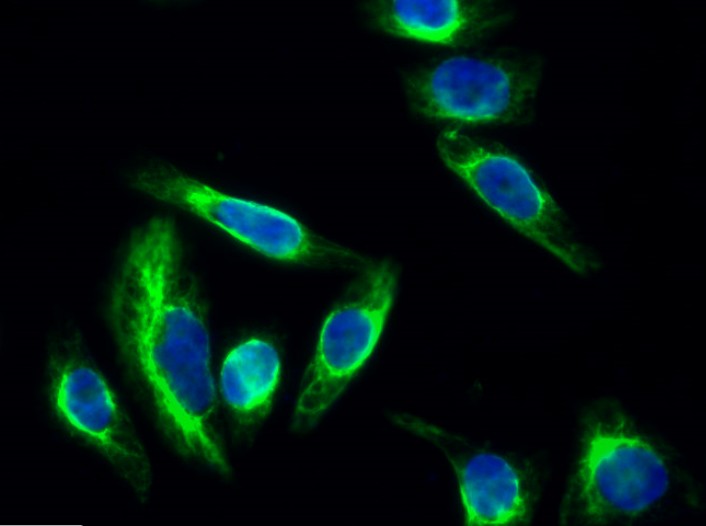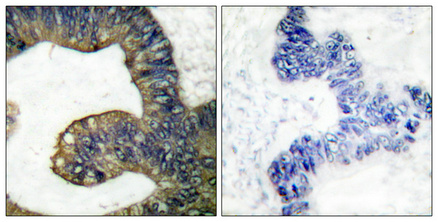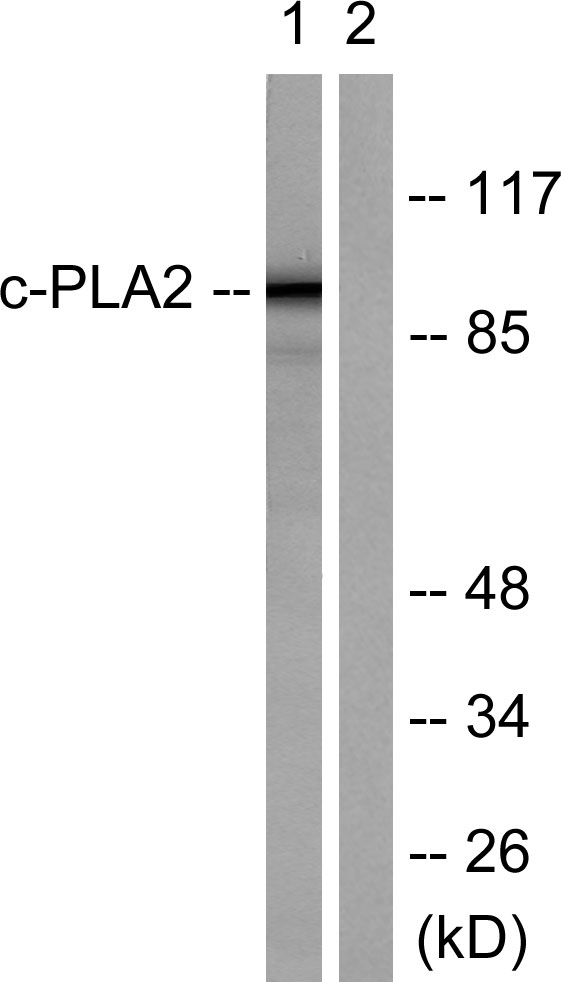cPLA2 Polyclonal Antibody
- Catalog No.:YT1084
- Applications:WB;IHC;IF;ELISA
- Reactivity:Human;Mouse;Rat
- Target:
- cPLA2
- Fields:
- >>Glycerophospholipid metabolism;>>Ether lipid metabolism;>>Arachidonic acid metabolism;>>Linoleic acid metabolism;>>alpha-Linolenic acid metabolism;>>Metabolic pathways;>>MAPK signaling pathway;>>Ras signaling pathway;>>Phospholipase D signaling pathway;>>Necroptosis;>>Vascular smooth muscle contraction;>>VEGF signaling pathway;>>Platelet activation;>>Fc epsilon RI signaling pathway;>>Fc gamma R-mediated phagocytosis;>>Glutamatergic synapse;>>Serotonergic synapse;>>Long-term depression;>>Inflammatory mediator regulation of TRP channels;>>GnRH signaling pathway;>>Ovarian steroidogenesis;>>Oxytocin signaling pathway;>>Choline metabolism in cancer
- Gene Name:
- PLA2G4A
- Protein Name:
- Cytosolic phospholipase A2
- Human Gene Id:
- 5321
- Human Swiss Prot No:
- P47712
- Mouse Gene Id:
- 18783
- Mouse Swiss Prot No:
- P47713
- Rat Swiss Prot No:
- P50393
- Immunogen:
- The antiserum was produced against synthesized peptide derived from human c-PLA2. AA range:471-520
- Specificity:
- cPLA2 Polyclonal Antibody detects endogenous levels of cPLA2 protein.
- Formulation:
- Liquid in PBS containing 50% glycerol, 0.5% BSA and 0.02% sodium azide.
- Source:
- Polyclonal, Rabbit,IgG
- Dilution:
- WB 1:500 - 1:2000. IHC 1:100 - 1:300. IF 1:200 - 1:1000. ELISA: 1:10000. Not yet tested in other applications.
- Purification:
- The antibody was affinity-purified from rabbit antiserum by affinity-chromatography using epitope-specific immunogen.
- Concentration:
- 1 mg/ml
- Storage Stability:
- -15°C to -25°C/1 year(Do not lower than -25°C)
- Other Name:
- PLA2G4A;CPLA2;PLA2G4;Cytosolic phospholipase A2;cPLA2;Phospholipase A2 group IVA
- Observed Band(KD):
- 110kD
- Background:
- This gene encodes a member of the cytosolic phospholipase A2 group IV family. The enzyme catalyzes the hydrolysis of membrane phospholipids to release arachidonic acid which is subsequently metabolized into eicosanoids. Eicosanoids, including prostaglandins and leukotrienes, are lipid-based cellular hormones that regulate hemodynamics, inflammatory responses, and other intracellular pathways. The hydrolysis reaction also produces lysophospholipids that are converted into platelet-activating factor. The enzyme is activated by increased intracellular Ca(2+) levels and phosphorylation, resulting in its translocation from the cytosol and nucleus to perinuclear membrane vesicles. Alternative splicing results in multiple transcript variants. [provided by RefSeq, Jul 2015],
- Function:
- catalytic activity:2-lysophosphatidylcholine + H(2)O = glycerophosphocholine + a carboxylate.,catalytic activity:Phosphatidylcholine + H(2)O = 1-acylglycerophosphocholine + a carboxylate.,domain:The N-terminal C2 domain, by its association with lipid membranes, mediates the regulation of CPLA2 by presenting the active site to its substrate in response to elevations of cytosolic Ca(2+).,enzyme regulation:Stimulated by agonists such as ATP, EGF, thrombin and bradykinin as well as by cytosolic Ca(2+).,function:Selectively hydrolyzes arachidonyl phospholipids in the sn-2 position releasing arachidonic acid. Together with its lysophospholipid activity, it is implicated in the initiation of the inflammatory response.,PTM:Activated by phosphorylation at both Ser-505 and Ser-727.,similarity:Contains 1 C2 domain.,similarity:Contains 1 PLA2c domain.,subcellular location:Translocates to membrane ve
- Subcellular Location:
- Cytoplasm . Golgi apparatus membrane . Nucleus envelope. Translocates to intracellular membranes in a calcium-dependent way. .
- Expression:
- Expressed in various cells and tissues such as macrophages, neutrophils, fibroblasts and lung endothelium. Expressed in platelets (at protein level) (PubMed:25102815).
Co-exposure to particulate matter and humidity increases blood pressure in hypertensive mice via the TRPV4-cPLA2-COX2 pathway ECOTOXICOLOGY AND ENVIRONMENTAL SAFETY Wei Yu IHC Mouse aortic tissue
Apolipoprotein C-III itself stimulates the Syk/cPLA2-induced inflammasome activation of macrophage to boost anti-tumor activity of CD8+ T cell. CANCER IMMUNOLOGY IMMUNOTHERAPY Jia Xiaoqin WB Mouse macrophages
Isoliquiritigenin limits inflammasome activation of macrophage via docking into Syk to alleviate murine non-alcoholic fatty liver disease SCANDINAVIAN JOURNAL OF IMMUNOLOGY Xiangyu Hu WB Mouse Splenic macrophages
Tanshinone I limits inflammasome activation of macrophage via docking into Syk to alleviate DSS-induced colitis in mice MOLECULAR IMMUNOLOGY Chunmiao Hu WB Mouse spleen macrophage
- June 19-2018
- WESTERN IMMUNOBLOTTING PROTOCOL
- June 19-2018
- IMMUNOHISTOCHEMISTRY-PARAFFIN PROTOCOL
- June 19-2018
- IMMUNOFLUORESCENCE PROTOCOL
- September 08-2020
- FLOW-CYTOMEYRT-PROTOCOL
- May 20-2022
- Cell-Based ELISA│解您多样本WB检测之困扰
- July 13-2018
- CELL-BASED-ELISA-PROTOCOL-FOR-ACETYL-PROTEIN
- July 13-2018
- CELL-BASED-ELISA-PROTOCOL-FOR-PHOSPHO-PROTEIN
- July 13-2018
- Antibody-FAQs
- Products Images

- Immunofluorescence analysis of Hela cell. 1,cPLA2 Polyclonal Antibody(green) was diluted at 1:200(4° overnight). 2, Goat Anti Rabbit Alexa Fluor 488 Catalog:RS3211 was diluted at 1:1000(room temperature, 50min). 3 DAPI(blue) 10min.

- Immunohistochemical analysis of paraffin-embedded Human colon cancer. Antibody was diluted at 1:100(4° overnight). High-pressure and temperature Tris-EDTA,pH8.0 was used for antigen retrieval. Negetive contrl (right) obtaned from antibody was pre-absorbed by immunogen peptide.

- Western blot analysis of lysates from HeLa cells, treated with TNF-a 20ng/ml 30', using c-PLA2 Antibody. The lane on the right is blocked with the synthesized peptide.



